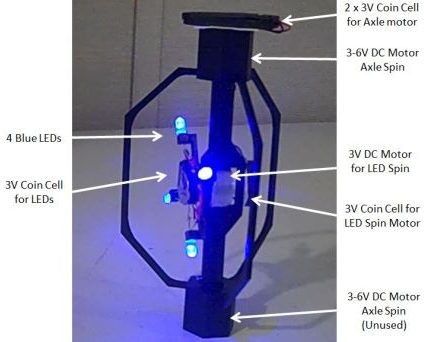 [Bithead] wanted to make a prop replica of an Electrostaff from Star Wars, but wasn’t sure how best to create the “crackling arcs of energy” effect at the business ends. After a few false starts, he decided to leverage the persistence of vision effect by spinning LEDs in more than one axis to create helical arcs of light and it seems that this method has some potential.
[Bithead] wanted to make a prop replica of an Electrostaff from Star Wars, but wasn’t sure how best to create the “crackling arcs of energy” effect at the business ends. After a few false starts, he decided to leverage the persistence of vision effect by spinning LEDs in more than one axis to create helical arcs of light and it seems that this method has some potential.
Many multi-axis persistence of vision devices use a component called a slip ring in order to maintain electrical connections across rotating parts, but [Bithead] had a simpler plan: 3D print a frame and give each axis its own battery. No centralized power source means a quicker prototype without any specialized parts, and therefore a faster proof of concept to test the idea.
[Bithead] already has improvements planned for a new version, but you can see the current prototype in action in the short video embedded after the break.
Slip rings can add bulk, but that’s offset by the advantage of putting power and electronics somewhere other than on the spinning parts themselves. An example of this is this Lucky Cat POV display, which uses a slip ring to let the arm spin freely while a microcontroller drives the LEDs on the paw.
No comments:
Post a Comment